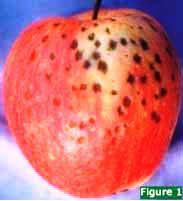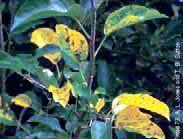Nutritional / Physiological Disorders of Apple
Nutritional / Physiological Disorders of Apple
Necrotic leaf blotch
 The disorder is characterized by the development of necrotic blotches or irregular areas of dead tissue in mature Leaves. A hormonal imbalance may be involved because symptoms are enhanced by gibberellins and reduced by abscisic acid. Foliar applications of zinc oxide also have been effective in reducing the severity of the disorder.
The disorder is characterized by the development of necrotic blotches or irregular areas of dead tissue in mature Leaves. A hormonal imbalance may be involved because symptoms are enhanced by gibberellins and reduced by abscisic acid. Foliar applications of zinc oxide also have been effective in reducing the severity of the disorder.
Lenticel breakdown

It is a physiological disorder affecting the surface of apples. Before the packing, there is little evidence of a problem; however, within a few days of packing, symptoms appear as dark brown pits in the fruit skin around the lenticels, reducing marketable yield. It usually occurs on the less sun-exposed side and along color margins. Early symptoms appear as small dimples. As firmness decreases, pits grow in size and depth. The flesh is not deeply affected except for a possible cavity directly under the pits. Generally, where symptom expression is low, relative calcium content in the peel is high and potassium content is low resulting in lower combined rations of [((K+Mg)/Ca) + (N/Ca)]. In contrast, where symptom expression is high, relative calcium content is generally lower and potassium higher.
IPM for Apple
To know the IPM practices for Apple, click here.
Source: NIPHM, and Directorate of Plant Protection, Quarantine & Storage
Last Modified : 3/1/2020
Natural enemies of apple insect pests are covered ...
This topic covers the information related to Pest ...
This topic covers the Information related to Disea...
This topic covers the information related to Insec...
